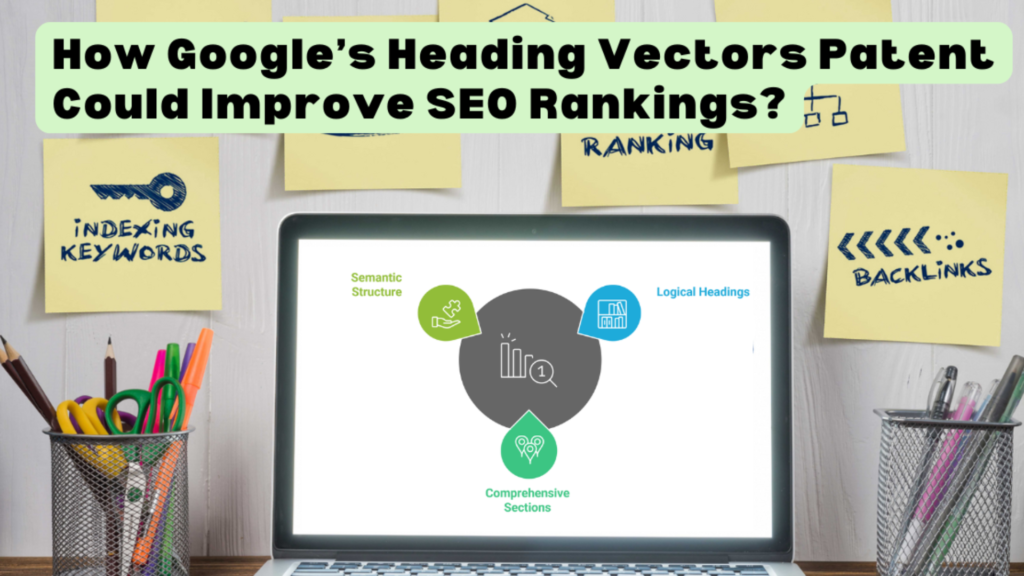Table of Contents
Toggle
Have you ever wondered how Google decides which part of a webpage to show as the best answer to your search? Well, it’s not just about keywords – it’s about context, structure, and relevance
Google’s patent, US 11,409,748 B1, officially titled “Context Scoring Adjustments for Answer Passages,” had introduced a nuanced way to evaluate and rank content using heading vectors.
Let’s break down what this Google’s Heading Vectors patent is about, how it works, and why it’s significant for SEO.
Understanding Heading Vectors
The concept of heading vectors revolves around how information in a document is organized hierarchically. According to the patent.
- A heading vector traces the path from a root heading (e.g., the title of a page) to a specific subheading or section containing the candidate content.
- This vector captures the relationships between headings and subheadings, creating a map of content structure.
For example, if you’re reading a web page titled “About the Moon,” the heading vector for a section discussing lunar orbit might look like this:
- Root: About the Moon
- H1: The Moon’s Orbit
- H2: How Long Does It Take for the Moon to Orbit Earth?
This organization provides context to the content beneath each heading, allowing Google to determine its relevance to a user’s query.
Key Features of the Google’s Heading Vectors Patent:
1. Contextual Scoring: Google assigns a context score to candidate passages based on their heading vector. This score adjusts the relevance of a passage by evaluating its position within the document’s hierarchy.
2. Depth and Coverage Boosts:
-
- Heading Depth: Deeper headings in the hierarchy may receive different scoring boosts depending on their relevance.
- Coverage Ratio: Content that fully addresses a topic within its section is given a higher boost compared to partial or fragmented answers.
3. Similarity to Query: The patent emphasizes matching the query’s intent with the text in headings. If a heading closely aligns with the searcher’s question, the content underneath it is prioritized.
4. Additional Factors: Unique elements like distinctive text (e.g., bolded terms), preceding questions, or list formats can also influence how passages are scored and ranked.
How Google’s Heading Vectors Impacts SEO
This patent sheds light on how Google may evaluate content structure and use it to rank web pages. Here’s what it means for your SEO strategy:
1. The Importance of Content Structure
-
- Organized Hierarchies Matter: Using clear headings (H1, H2, H3) to break down your content helps Google understand its context and relevance.
- Logical Flow: Ensure subheadings follow a natural progression. For instance, a guide on “Digital Marketing” might progress from “What is Digital Marketing?” to “Benefits of Digital Marketing” to “Strategies to Succeed.”
2. Optimize for Depth and Specificity
-
- Deep Content Wins: Sections with multiple levels of subheadings (e.g., H3 or H4) signal detailed exploration of a topic.
- Comprehensive Coverage: Avoid thin content. Fully address each subheading’s topic with actionable and relevant information.
3. Align Headings with User Intent
-
- Natural Language Queries: Match your headings to how users ask questions. For example, instead of “Moon Orbit Duration,” use “How Long Does It Take for the Moon to Orbit Earth?”
- FAQ Formats: Using question-based headings can help you align with user intent and rank for featured snippets.
4. Distinctive Text and Lists Are Key
-
- Highlight Important Points: Use bolded text, bullet points, and lists to make key information stand out.
- Leverage Lists: Google’s algorithms seem to favor content presented in list formats, especially for queries seeking step-by-step instructions or comparisons.
5. Query Similarity and Contextual Relevance
-
- Focus on long-tail keywords that naturally align with specific headings.
- Ensure content under each heading directly addresses the intent of that section, avoiding fluff or tangential information.
Practical Tips to Optimize for Heading Vectors
Here are actionable steps to align your content strategy with Google’s heading vector approach:
- Use Descriptive Headings: Avoid vague headings like “Introduction” or “Details.” Instead, use specific, descriptive headings like “What Are the Benefits of Remote Work?”
- Enhance Depth Strategically: Don’t overuse subheadings unnecessarily, but aim for a logical depth where each level adds value.
- Structure Long-Form Content: Use a clear table of contents for longer pieces, enabling Google to understand the document’s hierarchy.
- Incorporate Preceding Questions: Anticipate follow-up questions and address them in sequence to create a conversational flow.
- Test Coverage Ratios: Ensure your content under each subheading fully addresses the topic, covering statistics, FAQs, or examples where applicable.
Final Thoughts: A New Era of Contextual Relevance
Google’s heading vector patent reaffirms the importance of well-structured, user-centric content. It’s not just about keywords anymore—it’s about how you organize and present information. By focusing on structure, depth, and user intent, you can align your SEO strategy with how Google evaluates and ranks content.
